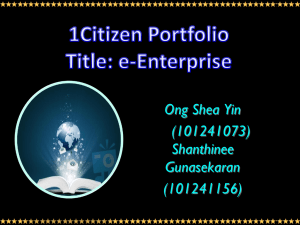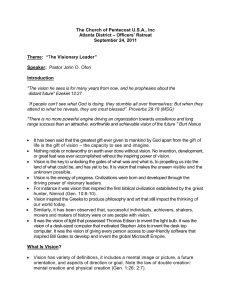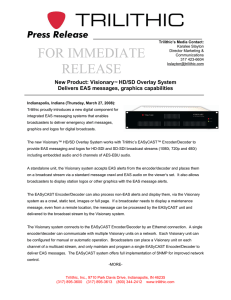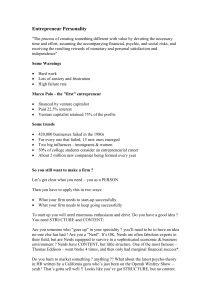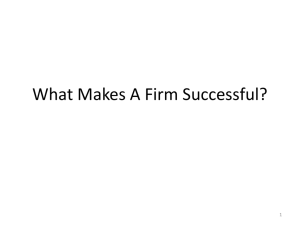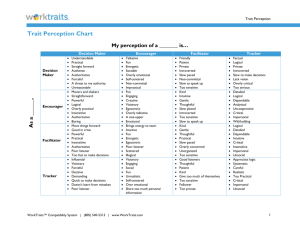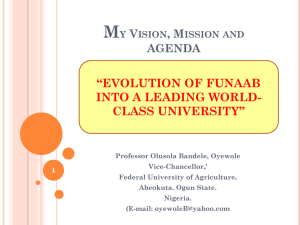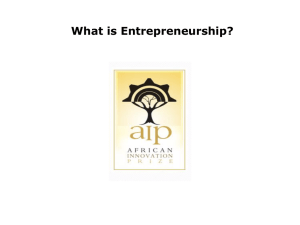Session 35 - Leadership Values and Visions
advertisement
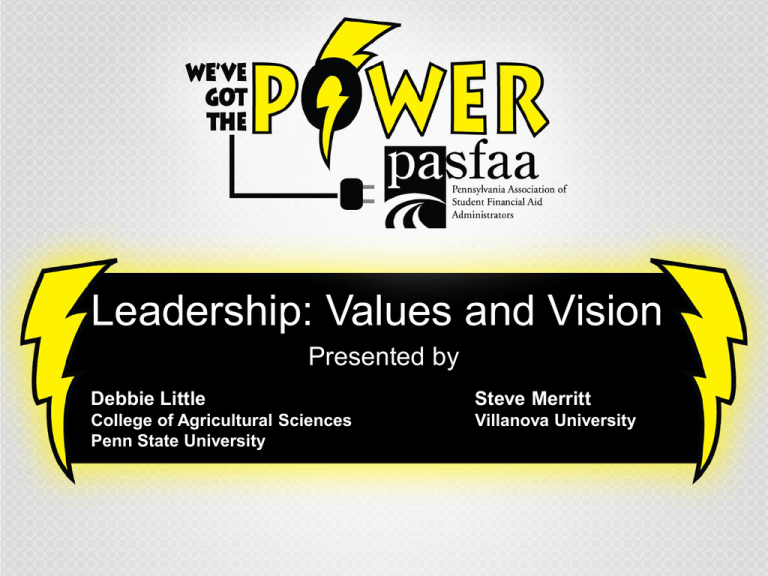
Leadership: Values and Vision Presented by Debbie Little Steve Merritt College of Agricultural Sciences Penn State University Villanova University Mind Awaken Exercise ACTIVITY: Identify the Values and Vision for NYC expressed by Mayor Bloomberg in the video clip Vision and Values What is the difference between having a vision and being a visionary leader? 3 The Importance of Vision 4 • Unites an organization – One direction – Purpose – Buy-in • Provides a clear path for the organization to take – Focus forward – Clear shared goals • Inspires creativity and innovation – Gives permission to think strategically, critically – Opens avenues for new ideas, products, programs, services • Is a vehicle to express an organization’s core values How Do You Wrap Your Head Around Vision? • Tell your story and emphasize your values • Structured and Linear Models Understand the Past – What has made this organization great? Understand past mistakes. Collect data. Analyze the Present – SWOT analysis is one example, a snapshot in time. Create the Future – “Conceptsmith” first; “Wordsmith” second. Select the Course – Set long and short term priorities, focus Unite the Organization – Get buy in, communicate effectively Foresight Process in Vision Development, B. Clarke and R. Crossland (2002) from The Leader’s Voice 5 “Name that Company” – “Our vision is to be the Earth’s most customer centric company; to build a place where people can come to find and discover anything they might want to buy online.” – “To be led by a globally diverse workforce that consistently delivers outstanding business results, understands the various cultural demands of a global marketplace, is passionate about technology and the promise it holds to tap human potential, and thrives in a corporate culture where inclusive behaviors are valued.” – “______ will be a global university, committed to excellence, with a passion for creating knowledge and educating students to be leaders for a better tomorrow” 6 Vision and Visionary Leadership Defined • Vision should describe a set of ideals and priorities, a picture of the future, a sense of what makes the company special and unique, a core set of principles that the company stands for, and a broad set of compelling criteria that will help define organizational success. -Oren Harari Business professor at the University of San Francisco as well as an author of several management books, including The Leadership Secrets of Colin Powell.) • Vision creates a realistic, credible, attractive future for [an] organization. -Burt Nanus Author or coauthor of six books including the best-selling Leaders: Strategies for Taking Charge (1985, with Warren Bennis). He was director of research at the University of Southern California's Leadership Institute and professor of management in the School of Business Administration.) Source: National Defense University http://www.au.af.mil/au/awc/awcgate/ndu/strat-ldr-dm/pt4ch18.html 7 Vision and Visionary Leadership Defined • • • • • • Builders of a new dawn Work with imagination, insight, and boldness Present a challenge Call forth the best in people Brings people together around a shared sense of purpose Work with the power of intentionality and alignment with a higher purpose • They are social innovators and change agents • They see the big picture and think strategically Source: THE CENTER FOR VISIONARY LEADERSHIP http://www.visionarylead.org/ 8 Vision and Visionary Leadership Defined • Profound interconnectedness between the leader and the whole • True visionary leaders serve the good of the whole • They recognize that there is some truth on both sides of most polarized issues • They search for solutions that transcend the usual adversarial approaches to problem solving • They find a higher synthesis of the best of both sides of an issue • They address the systemic root causes of problems to create real breakthroughs. Source: THE CENTER FOR VISIONARY LEADERSHIP http://www.visionarylead.org/ 9 Example of a Visionary Leader Alexander the Great 10 Examples of Other Visionary Leaders Maya Angelou Susan B Anthony Winston Churchill Marie Curie John F. Kennedy Martin Luther King Abraham Lincoln Ronald Reagan Margaret Thatcher 11 Becoming a Visionary Leader • How does a person become a visionary leader? • Talk amongst yourselves…. 12 We love Debbie and Steve! Values Driven Leadership • A conscious commitment by leaders at all levels to – lead with their values – create a corporate culture that optimizes financial performance, ethical practice, social contribution and environmental impact • Values-driven leaders lead – from a deep sense of purpose – with a demonstrated commitment to life-affirming values, such as honesty, integrity, excellence, courage, humility, trust, care for people and social and environmental responsibility. Source: Center for Values-Driven Leadership, Benedictine University 13 http://cvdl.org/valuesdriven_leadership/definitions.asp Values-Oriented Leaders Defined • Traits or qualities that are considered worthwhile • Represent an individual’s highest priorities and deeply held driving forces. • Important and enduring beliefs or ideals shared by the members of a culture • Exert major influence on the behavior of an individual • Serve as broad guidelines in all situations Sources: Build an Organization Based on Values -- The Strategic Planning Framework for Vision, Mission, Values Susan M. Heathfield, http://humanresources.about.com/od/strategicplanning1/a/organizvalues_2.htm Business Directory http://www.businessdictionary.com/definition/values.html#ixzz1xn3qFQwC 14 Examples of Values • • • • • • • • • • • • • • • • 15 Ambition Competency Individuality Equality Integrity Service Responsibility Accuracy Respect Dedication Diversity Improvement Enjoyment/fun Loyalty Credibility Honesty • • • • • • • • • • • • • Innovativeness Teamwork Excellence Accountability Empowerment Quality Efficiency Dignity Collaboration Stewardship Empathy Accomplishment Courage • • • • • • • • • • • • • • Wisdom Independence Security Challenge Influence Learning Compassion Friendliness Discipline/order Generosity Persistence Optimism Dependability Flexibility Example of a Values Oriented Leader Jane Goodall • • • • 16 Primatologist, ethologist, and anthropologist Professional recognition and public renown for her 45-year study of chimpanzee social and family life Founded and directs the Jane Goodall Institute Active in efforts to advance the power of individuals to take informed and compassionate action to improve the environment for all living creatures. Examples of Values Oriented Leaders Jimmy Carter Yvon Chouinard Mahatma Gandhi Jane Goodall Eleanor Roosevelt 17 Values as Part of Your Organization’s Culture • What are the VALUES your organization uses as the basis for its operation and existence? • Talk amongst yourselves…… 18 Level 5 Leadership Good to Great, by Jim Collins • Blending “personal humility with professional will” • Professional Will - Creates superb results no matter how difficult; sets standards for building an enduring organization; looks in the mirror not out the window in taking responsibility • Personal Humility - Compelling modesty, shuns adulation, never boastful; acts with quiet determination; does not rely on charisma to motivate; channels ambition into the next generation; looks out the window not in the mirror to give credit where it is due 19 Level 5 Leadership Good to Great, by Jim Collins • “It’s not that Level 5 leaders have no ego or self-interest. Indeed, they are incredibly ambitious – but their ambition is first and foremost for the institution, not themselves.” • Level 5 Leaders have a strong vision for their company, organization, or institution blended with drive to succeed, an understanding of how to set up the next generation for success, and “unwavering resolve to do what must be done.” 20 Value and Vision in Practice SITUATION: Highly personal, undergraduate liberal arts college in a rural location; notable past; current/serious enrollment issues. Must “realign” its future with a sustainable strategy in order to survive. Realignment has significant impact on institutional values and consensus vision. 21 Choices to Consider…. [Review all options and identify/discuss the values and vision issues each present to the college.] MARKETING • Rethink recruiting practices • Reduce admission standards • Increase discount to meet enrollment goals. FINANCE • Reduce personalized approach to undergrad ed • Hire third party providers • Emphasize on-line, non-credit degrees/classes • Increase class sizes • Employ adjunct faculty • Reduce holistic approach 22 PRODUCT • Redesign curriculum, more career oriented, practical, functional • Reorient institution’s brand • Change marketing messages to align with new “outcomes” orientation PRINCIPLED (FINIS) • Maintain institutional mission and choose to close the institution Thank you! Debbie Little College of Agricultural Sciences Penn State University dxm16@psu.edu Steve Merritt Villanova University stephen.merritt@villanova.com 23
